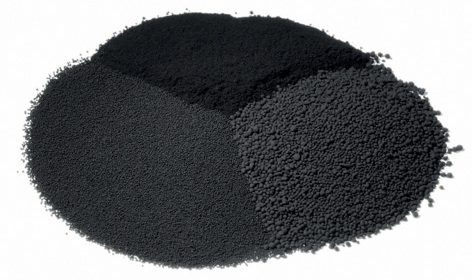

The mixing action of the machine over time results in a stable dispersion.

The collisions and compacting between the beads break the particles apart. The bead mill works like a filtering system. But for fine grinding of carbon black, high-speed dispersion does not completely de-agglomerate the particles. Typical high-speed dispersing with a sawtooth blade rotating at a shear rate of 600-800 sec-1 begins to de-agglomerate pigment particles. The function of the pigment dispersant is to therefore wet, disperse, and stabilize the pigment dispersion in its carrier solvent and to maintain stable particle distributions in the finished letdown formulation. In addition, they are important to the suspension and homogeneous dispersion of the pigment particles in the carrier medium as they are being milled and subsequently during storage. Pigment dispersants are provided in the pigment dispersion to facilitate the wetting process.

The dispersion vehicle must displace contaminants such as air from these surfaces and wet the pigment particles. We must consider the tremendous amount of surface area of finely divided carbon black pigment particles. The goal of the test work done for this discussion was to show that carbon black disperses to an extremely fine particle size very quickly through judicious choices of grinding media size and dispersant copolymer.ĭispersion techniques typically include a media milling/grinding process in which the pigment agglomerates are broken down into smaller agglomerates and/or individual particles which are wetted by the carrier medium. Moreover, long exposure times increase the natural tendency of pigment particles to agglomerate during the milling process, and this leads to the production of unstable dispersions. This can lead to wear on the grinding media that reduces milling effectiveness due to both bead size irregularities and contamination. Long exposure times are often required to achieve the desired degree of dispersion. This paper describes the effects of bead mill size and dispersant chemistry on particle size reduction for difficult-to-disperse carbon black pigment.ĭispersion of carbon black pigment in water via bead milling is very difficult due to the extremely fine particle size of this material. Therefore, optimum utilization of both bead milling and chemical technologies is necessary to most efficiently achieve stable dispersions with the target particle size characteristics. 3, 2003 in New Orleans, LA.Ībstract: Producing fine particle size and narrow particle size distributions in aqueous organic pigment dispersions is a significant challenge. Editor’s Note: “Fine Grinding of Carbon Black” was presented at NIP 19: International Conference on Digital Printing Technologies, Sept.


 0 kommentar(er)
0 kommentar(er)
